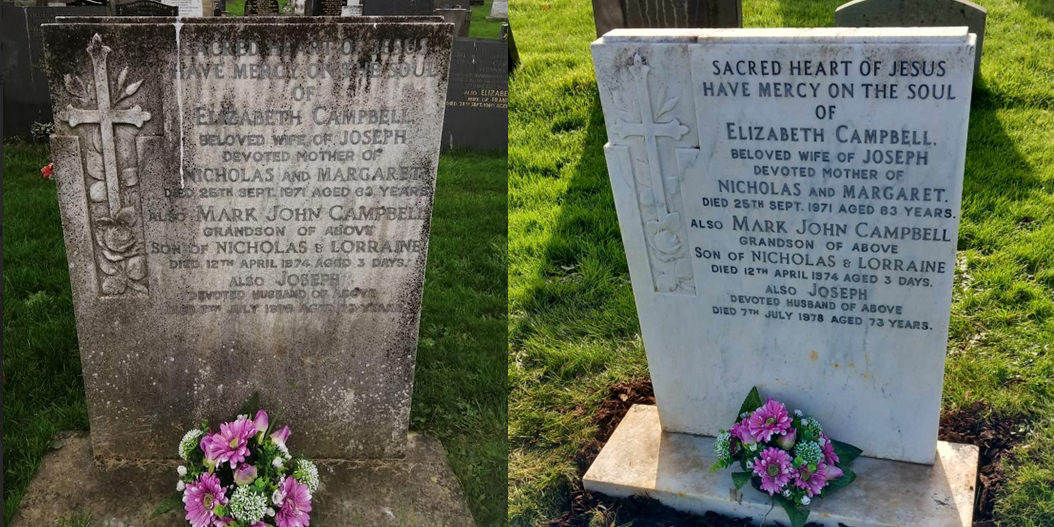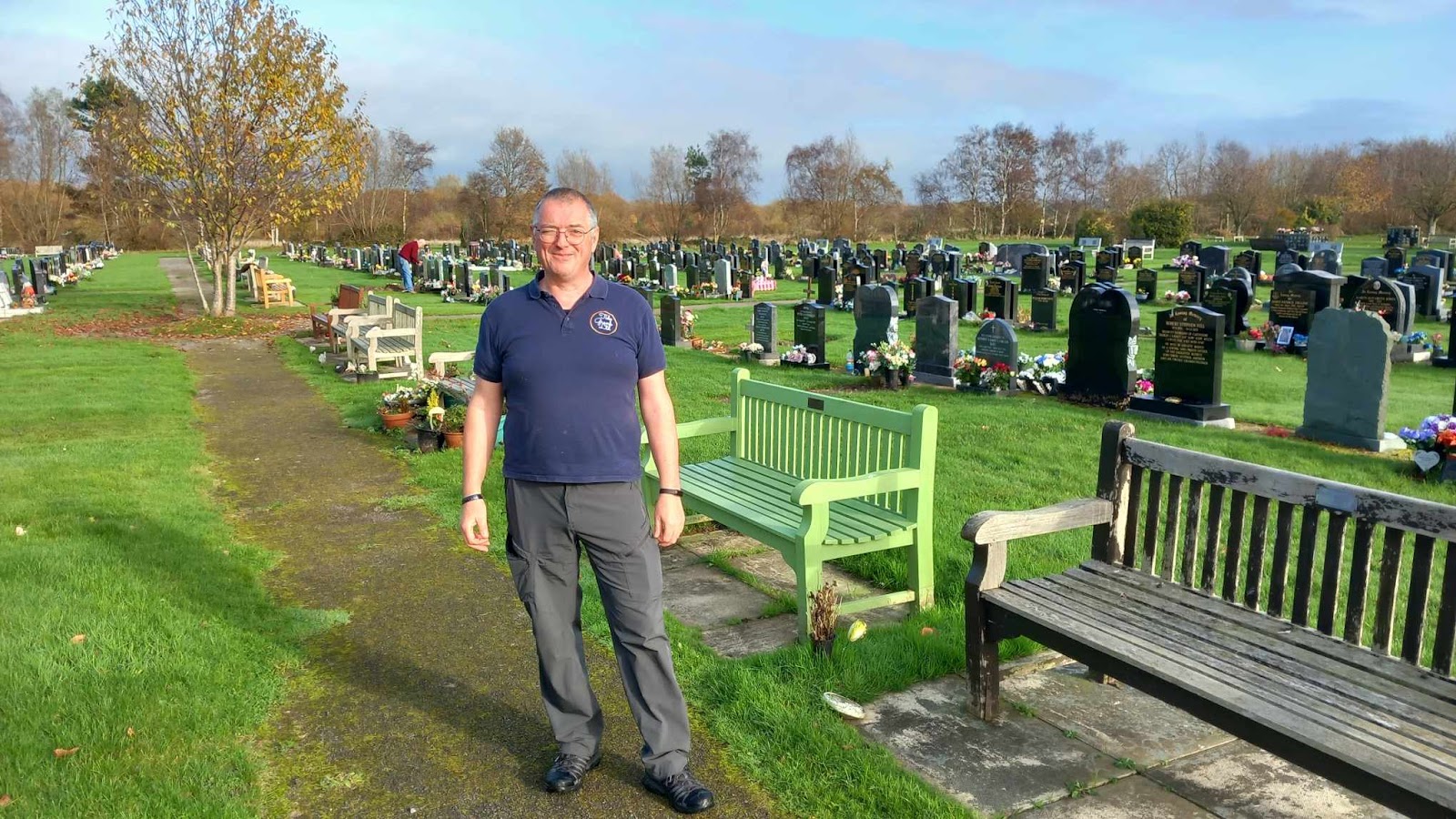After Tony's wife died, he wanted to despair. Instead, he started caring for strangers' graves

'I’ve had people on the phone crying with gratitude, and with the guilt they’d carried with them'
We’re walking between graves on a chill autumn day. Tony Maher, my Virgil through Thornton cemetery, treads respectfully between the headstones, laid out before us like endless rows of marble teeth in varying states of decay. He points out the inevitable plaque of algae, moss, and lichen that, through the degradation of time, eventually leave the heartfelt elegies of loved ones barely legible. On some, a bright rectangle has been hastily bleached to add another name of the dead.

“Bleach can actually cause micro-damage to the stone,” Tony explains. “You have to use a biological growth remover. The stuff I have, it’s only one pH off water – but once you apply it, it begins working with the rain and the elements, so the stone actually improves over time.”
Tony, founder of Tidy Graves Limited, is a veritable Wikipedia of technical grave-tending information. Born, but not bred, in Walton – his father’s stint in the Air Force meant he spent his early years in Singapore and then all over, finally settling back in Merseyside in his thirties – Tony tends graves in the North of Liverpool up towards Preston, and from Southport over to Wigan. During our walk, he shows me before-and-after pictures of gravesites he’s looked after since he started his business four years ago. The effect in person is almost anachronistic shock. I find myself standing at the resting places of people who died decades before I was even born, their marmoreal tablets scrubbed and re-lettered back to the original whites and golds until you’d swear they were interred yesterday.
November is the month of remembrance, beginning with All Souls’ Day and Dia de los Muertos, continuing with Remembrance Sunday and month-long prayers for the Holy Souls in Purgatory in the Catholic tradition. Perhaps it’s something about the crisp wind, the pallid hue of the sky or its pervasive ashen veil of cloud, that inclines us towards contemplation at this time of year.
I ask Tony how Tidy Graves began. “Twelve years ago, my wife was diagnosed with cancer,” he says. “She was given three months to live, but fought on for two years.”
What was that like? “I was left being both mum and dad to a six-year-old girl and an eight-year-old boy. I was a decent dad, but I didn’t know how to be a mum.”
Thankfully, Tony’s in-laws made good on their promise to remain active in his and the children’s lives. He laboured on, working as a finance manager. But he had arthritis in his spine, causing constant problems with his back.
“And there was a period of time when I struggled to go to the grave,” he says. “Work, life, everything – trying to balance all of these things got in the way. And when I did go, I noticed how quickly things started overgrowing. The church[yard] was basically run by volunteers. They did a great job, but they didn’t look after the grave in particular – just the surrounds.”
Witnessing this creep of entropy into the burial ground is when a germ of an idea started for Tony. But in the meantime, life continued.

“I met an old friend, who was going through a few problems herself,” he says. “We’d worked in the same place years before.”
This friend, Jenny, began to help Tony with the mothering side of parenthood he’d struggled with.
“She had a little lad, too. It took a lot of pressure off. And the fact she’d known my wife, too, that helped. And…” He pauses, very briefly, to nail down the right words. “From our friendship, something started to rekindle. We got closer.”
Although happy with the slow-burning romance, Tony’s health was becoming more of a problem. Not just his spinal arthritis, but the fact he wasn’t eating well.
“You don’t, when you’re juggling all of these things,” Tony says. “And I found the environment I was working in was becoming toxic.”
As a fellow veteran of finance departments, this resonates with me. Sedentary work is conducive to neither one’s physical nor mental wellbeing. We talk about how, extrapolated over five, ten, fifteen years, this desk-bound gazing into spreadsheets and figures engenders a diminishment of, for want of a better word, the soul.
“I now look back, and think, [the workplace] hadn’t become toxic – it was just the normal business of internal politics,” Tony reflects. “But something within me had changed. I wanted to do something good. I wanted to help. I didn’t just want to make money. I just wanted something different.”
This soul-searching led to a huge decision. Tony took a two-year sabbatical from work. He also joined the gym, started taking more vitamins and minerals to ease his arthritis, and began fasting intermittently. Within a year, he’d dropped five stone. Meditation helped his mental state.
“Then Covid hit,” he says.
Jenny, who worked for the local council, knew lockdown was about to happen. She and Tony had been talking about moving in together for a while, but the pandemic forced their hand.
“She grabbed her suitcase, grabbed her lad, and moved in with me,” Tony recalls.
Coming out of the first lockdown, “We realised the house wasn’t quite suited for all five of us, but we also realised we wanted to be together.”
Eventually, they rented an old vicarage in Lydiate, right next to Sir Thomas’s Church. The relatively bucolic environment of the ecclesiastical grounds and nearby farms suited Tony. The cemetery was just over the wall from the vicarage, and he began noticing people going to the graveyard to visit loved ones or lay flowers.
Then the next lockdown hit, and visitors were fewer.
“So I just started tidying up bits around the graves,” Tony says. “Taking away dead flowers, nothing major. I was enjoying it as part of my [sabbatical].”
Even outside of lockdown, there are many reasons why people may not be able to attend a grave. “I went through a period when, emotionally, I couldn’t go,” Tony says, remembering the painful time after his wife’s passing. Age and infirmity can also be a hindrance. “There are also people who move away and take a lot of guilt with them.”
Tony’s pastime became a vocation. He began Tidy Graves, learning as he went. Talking with stonemasons helped him become proficient in treating the headstones correctly. An artist taught him how to letter and re-letter the epitaphs. Four years on from Covid, he can explain the practical difference between gold paint and goldleaf; how to prime the stone; how to make it glimmer even in the November half-sun above us; the problems with lead versus resin lettering. His dozens of insights leave me dazzled.

From neolithic cairns to the Pyramids of Egypt, from Tibetan sky-burial to the humble country churchyard, interment has always weighed heavily on the human psyche. My conversation with Tony, a voracious reader, makes me think of Priam kissing the hands of Achilles that killed his son Hector in order to reclaim the corpse for a proper funeral, or the treacherous journey of the Bundren family in As I Lay Dying to lay their mother Addie to rest. But burial is one thing – what happens to the gravesite afterwards has a more ambiguous emotional resonance.
“‘If [the dead] cared, they’d do it themselves’,” Tony says, quoting one of the comments he received when he started posting online the before-and-after photos of graves he’d cared for. On the other hand, “I’ve had people on the phone crying with gratitude, and with the guilt they’d carried with them.”
Since he left office work, “I’ve had no problems with my back,” Tony says, tapping his head in lieu of nearby wood. But he still needs to consciously think about his movements, which has the side-affect a kind of meditative mindfulness. He strikes me as someone constantly in-tune with his environment.
“It’s funny – different graveyards have different heartbeats,” he tells me. What about this one? “Very busy over this side,” he says, referring to the row of freshly dug graves not far from where we’re walking. “But over there” — he gestures to the far side of Thornton cemetery, past the crematorium building where, only months ago, my wife and I said goodbye to her beloved aunt — “it’s much quieter and more peaceful.”
We walk towards the peaceful side. The dates on one of the tombstones we visit, now nearly as fresh as the day it was cut, reads 23rd NOVEMBER 1974 – 28th NOVEMBER 1974. Tony maintains a respectful emotional distance from all the sites he attends, but adheres to a kind of Golden Rule: treating each one like he would want his own to be treated. Standing at a child’s resting place, I admire his ability to compartmentalise – something he says helped him return to work after his own bereavement.
A decade on, can Tony visit his wife’s grave? “I do go,” he says. “Not as often as I’d like, because life and work get in the way, don’t they? But I don’t have the same emotional block I used to. So I attend, and tend to her. And life goes on.”
So, it seems, does death. As we walk past a mourning party leaving the crematorium, it occurs to me that something about the catharsis of a funeral and the disrepair of a memorial stone may have a causal relationship. But the many dimensions of love also have a corresponding match in the grieving process. I find myself hoping that Tony’s steady, confident demeanour and professionalism continue to make Tidy Graves a reliable Merseyside port in the ebb and flow of grief, regret, and guilt, all proportional to the love that bore them.
As I reach Blundellsands, a pale sun has begun to creep from behind the clouds.

Comments
Latest
I’m calling a truce. It’s time to stop the flouncing
The carnival queens of Toxteth
The watcher of Hilbre Island
A blow for the Eldonians: ‘They rubber-stamped the very system they said was broken’
After Tony's wife died, he wanted to despair. Instead, he started caring for strangers' graves
'I’ve had people on the phone crying with gratitude, and with the guilt they’d carried with them'